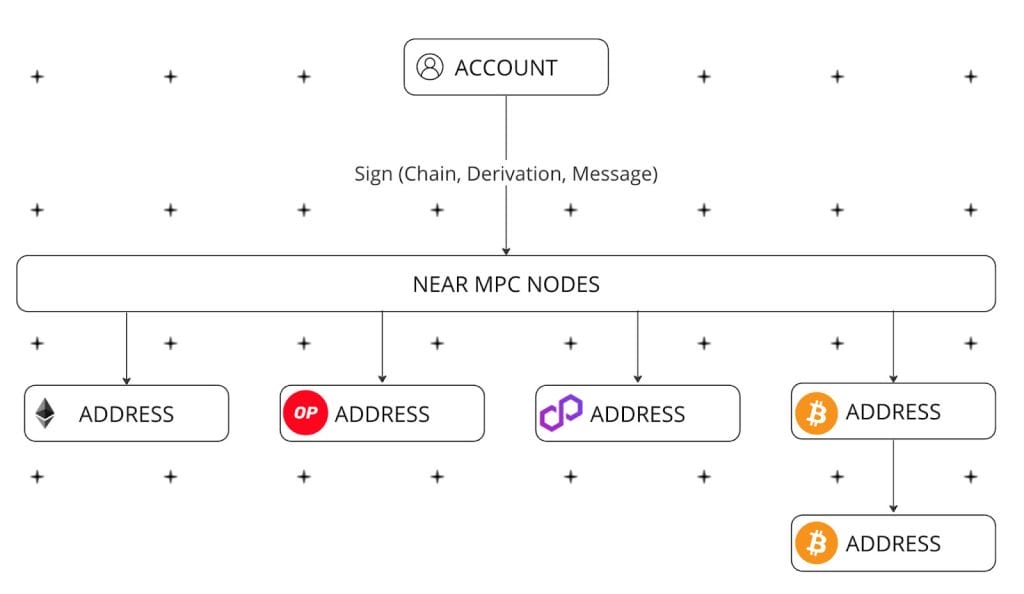The NEAR Foundation, the non-profit organization supporting the Layer 1 NEAR Protocol, launched chain signatures on its mainnet on August 8.
According to an official announcement, these chain signatures allow users to sign transactions on different blockchains directly from their NEAR accounts, eliminating the need for traditional cross-chain bridges.
The 2 Types of Users
Crypto natives and the average person.
Crypto natives want a seamless experience across chains, while regular users just want to solve problems or have fun without caring about the tech behind it.
Chain Signatures enables developers to create experiences… pic.twitter.com/WuFHqsvoNV
— NEAR Protocol (@NEARProtocol) August 9, 2024
Currently, NEAR’s chain signatures support Bitcoin (BTC), Ethereum (ETH), including EVM-compatible chains, Dogecoin (DOGE), Ripple (XRP), Cosmos (ATOM), and Polkadot (DOT), among others, with plans to extend compatibility to Solana (SOL) and other chains in the future.
How Chain Signatures Work
Chain signatures offer a novel approach to cross-chain interactions. They link NEAR account addresses to other blockchains using a method called additive key derivation. This process generates multiple subkeys from a single master key, allowing for the management of different blockchain accounts.
When a user initiates a cross-chain transaction, a smart contract on the NEAR blockchain requests a signature for the transaction on the target blockchain. This request is fulfilled by a multi-party computation (MPC) service.
This service, initially secured by eight validators including Pagoda, Luganodes, The Lifted Initiative, InfStones, Staking4All, Node.Monster, Black Sand Technologies, and Aurora, operates in a decentralized manner, preventing any single entity from compromising user funds.

Benefits of Chain Signatures
By enabling users to interact with multiple chains using a single account, NEAR seeks to support the development of cross-chain decentralized applications (DApps) and the creation of omnichain tokens. The company positions this development as a big step towards a more interconnected blockchain ecosystem, reducing barriers to entry, liquidity, and usability.
“Chain signatures is a game-changing innovation that brings chain abstraction to life,” said Illia Polosukhin, CEO of the NEAR Foundation. “Whereas before we had fragmented liquidity in DeFi, now there will be a single DeFi layer for all chains”. According to Polosukhin, wallets, addresses, bridging, and token gas fees are no longer necessary.
“Instead, all of DeFi is accessible from wherever users already are. It’s all possible because smart contracts can now sign transactions for any blockchain, even Bitcoin,” Polosukhin added. “This opens up a whole new design space for financial apps in Web3, benefitting degens and also paving the way for new user bases.”
Chain signatures is a core component of NEAR’s broader strategy to achieve chain abstraction, a concept that seeks to create a unified user experience across different blockchain networks. By abstracting away the complexities of interacting with multiple chains, NEAR hopes to make decentralized finance more accessible to a wider audience.
NEAR remains the second most used blockchain, by daily active users, at 1.95 million, just below TRON at 2.1 million, according VanEck July 2024 report. Just over 1 year ago NEAR had only 67k daily active users.
Most of NEAR’s usership is billed to be user-generated rather than bot-created, as NEAR’s activity relates to a discount shopping application called Kai Kai, which is based in Taiwan.
The post Chain Signatures Go Live on NEAR Protocol, Expand Cross-Chain Possibilities appeared first on Cryptonews.

